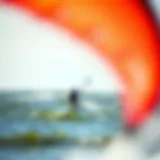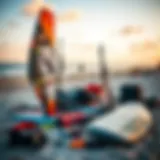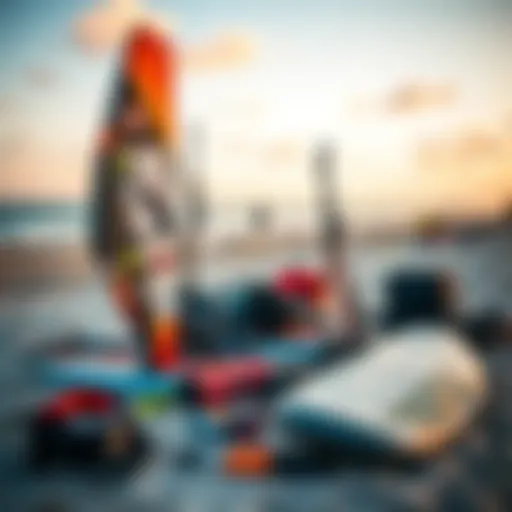A Beginner's Guide to Wing Foiling Techniques


Intro
Wing foiling is gaining a foothold in the watersport community, attracting a diverse range of enthusiasts. Combining the essence of kite surfing and windsurfing, it provides a unique opportunity to glide over water in a serene yet exhilarating manner. For those just dipping their toes into this world, understanding the ins and outs can seem overwhelming. Fear not, as this guide aims to illuminate the path to mastery, laying the groundwork for a thrilling journey.
By exploring vital concepts like specialized gear, essential techniques, and safety protocols, this guide ensures that beginners can embark on their wing foiling venture with both confidence and competence. Each segment is crafted to foster a deeper appreciation for the sport, equipping readers with the necessary insights to navigate their initial experiences.
As we prepare to dive in, the following sections will unfold with clarity and precision, steering you toward not only understanding wing foiling but also embracing it fully. Let's get started!
Gear Insights
When it comes to wing foiling, having the right gear is crucial. Understanding your equipment can make a significant difference in performance and enjoyment.
Essential Gear for Beginners
Before hitting the water, you’ll need to assemble a collection of items that ensure both safety and performance. Here are the basics that every novice should consider:
- Wing: The heart of your setup. Look for a wing that matches your skill level, wind conditions, and preferences in size. Brands like Duotone and Fanatic offer models specifically designed for beginners.
- Board: Choose a board that provides stability and buoyancy. A larger board will help you find your footing and maintain balance.
- Foil: A beginner-friendly foil should have a larger wing area for increased lift and lower aspect ratio for better stability at lower speeds.
"Investing in well-suited gear from the start can set the tone for your entire experience."
Latest Gear Reviews
The market is constantly evolving, with new products surfacing to enhance the wing foiling experience. Pay attention to feedback from fellow wing foilers on online forums, such as Reddit. It’s not uncommon for users to share insights about their latest purchases, highlighting what works and what doesn’t.
For instance, the Naish Wing-Surfer has gained attention for its user-friendly design and durability, making it a top pick for newcomers.
Techniques and Tips
Once you have your gear sorted, the next step is to grasp the fundamental techniques that will lay the groundwork for your skills progression.
Safety Practices for Kiteboarders
Safety should always be your top priority. Start with these essential practices:
- Wear a Leash: Attach a leash to your wing to prevent losing it in the water.
- Use a Personal Floatation Device (PFD): Always wear a PFD, regardless of your skill level.
- Know the Weather: Familiarize yourself with local wind and water conditions to avoid dangerous situations.
Advanced Tricks and Techniques
After mastering the basics, you may want to delve into more advanced maneuvers. Learning to jibe or tack can enhance your skills, increase your confidence, and expand your capabilities on the water. Additionally, consider watching tutorials to visually understand these moves.
Understanding Wing Foiling
Wing foiling represents a thrilling intersection of wind and water, coupling the adrenaline of surfing with the flight of hydrofoiling. It's a fresh sport that has attracted a variety of enthusiasts, from kiteboarders looking to branch out to adventurers seeking a unique experience on the water. Understanding the nuances of wing foiling is crucial for beginners, as it lays the foundation for both safety and enjoyment.
The sport's increasing popularity urges newcomers to get familiar with its mechanics, flow, and the proper mindset needed to master it. By delving into the core components of wing foiling, beginners can glean valuable insight into not just how to ride, but also how to embrace the process fully, making it a rewarding venture.
Historical Context
Before the wings graced the waters, windsurfing ruled the scenes. It was a bold idea—a sail coupled with a board. Fast-forward to a few years ago, when wing foiling emerged, drawing inspiration from kiteboarding and windsurfing while introducing its unique twists. The major leap happened when the boards became buoyant enough to allow hydrofoiling, retrofitting wind sports with a fresh lease of life. Those early adopters, experimenting with different setups, paved the way for the boom we see today.
"Innovation in sports doesn't just happen overnight; it evolves, shaped by the enthusiasm of the riders who dare to mix and match elements until something spectacular emerges."
Wing foiling is still in its infancy, but it’s gained momentum rapidly. It's common to hear about individuals testing out a wing on various water bodies, mastering skills that were once remains of fantasy. As the community grows, it’s critical to trace back the roots of the sport to appreciate how we got here.
What is Wing Foiling?
Wing foiling is a dynamic sport where a rider balances on a board with a hydrofoil while holding a wing. The wing acts like a sail but is designed to be handheld. Riders use the wind to lift themselves above the water, reducing drag significantly, which allows for a smoother glide and the ability to ride in lighter winds compared to traditional windsurfing.
The basic setup includes:
- Wing: A large inflatable wing that captures wind.
- Board: A buoyant board that provides stability.
- Foil: An aerodynamic structure beneath the board, enabling lift.
Together, these components work harmoniously to create a unique combination of surfing, sailing, and flying—all rolled into one exhilarating experience. Understanding how each part operates contributes to a rider's ability to adapt to different conditions, making the learning curve not just about skill, but also about awareness of the equipment being used.
Comparative Overview with Other Water Sports
When comparing wing foiling with kiteboarding and windsurfing, several differences and similarities arise:
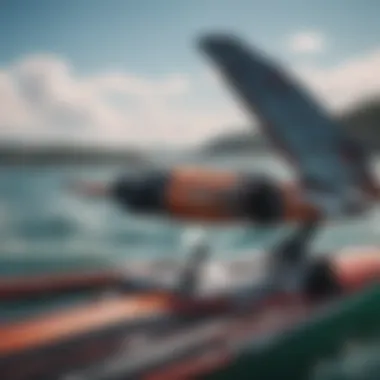

- Physical Connection: In kiteboarding, riders are leashed to a kite, whereas in wing foiling, they hold a wing that's independent. This allows for swift directional changes and less resistance.
- Wind Dependency: While all three sports rely on wind, wing foiling shines in light winds, making it more accessible for various conditions and skill levels.
- Skill Transition: Those with backgrounds in kiteboarding or windsurfing often find familiar ground in wing foiling. However, it has a distinct learning curve that can pose challenges, especially in balance and coordination.
In short, wing foiling offers a fresh twist on essentials from these water sports, beckoning adventure lovers to embrace the winds in a different way. By understanding how it intersects with known disciplines, newcomers can relate their experiences in similar sports, fostering quicker learning and adaptation.
Essential Equipment for Beginners
When venturing into the world of wing foiling, having the right equipment is not just an afterthought. It’s a prerequisite for a successful and enjoyable experience. The nuances of wing foiling make it vital for beginners to understand the components they will rely on as they cruise through waters. Selecting the appropriate gear not only enhances performance but also plays a crucial role in safety and comfort.
Wing Characteristics
The wing is the heart of your wing foiling experience. Unlike traditional sails, these wings are designed to be simple yet effective, allowing you to harness wind energy effortlessly. At their core, wings are lightweight and made from durable materials that ensure longevity.
- Size and Shape: The size of the wing greatly influences how easily you can get on the foil. Larger wings provide more lift at lower speeds, making them ideal for beginners who need to establish their balance and control. On the flip side, smaller wings are better suited for higher speeds and more experienced riders.
- Handles and Straps: When choosing a wing, pay attention to the handles and adjustable straps. These features allow you to maintain a firm grip while adjusting your body position for optimal performance. Beginners should look for wings with multiple handles to provide flexibility in maneuvering.
- Material Quality: While most wings are made of synthetic fabrics, the quality can differ significantly. Fabrics that are treated with UV resistance or have reinforced seams will enjoy a longer lifespan. Make sure you're investing in a wing that stands the test of time and weather conditions.
Foil Selection
Foils can often be the unsung heroes of wing foiling. They are the components that lift you out of the water, making it possible to glide above the surface. Choosing the right foil is crucial, as it directly impacts the ride quality.
- Foil Size: The sizing of the foil typically correlates with your weight and skill level. A larger front wing provides easier lift for those just starting, while experienced riders might opt for smaller foils to achieve higher speeds and advanced tricks.
- Fuselage and Stabilizer: The fuselage connects the front wing to the rear, affecting both stability and maneuverability. A longer fuselage may lead to smoother rides; beginners might find it beneficial to start with a shorter one for easier turns. The stabilizer at the rear also impacts balance and control, playing a significant role as you gain skills.
"Picking the right foil can transform your experience—it’s like choosing the right pair of shoes for a long hike. Invest wisely."
Board Types and Sizes
While the wing and foil are essential for lift, the board you ride on can drastically alter your experience on the water. The right board offers stability, comfort, and efficiency.
- Board Size: Larger boards provide a greater surface area, which is beneficial as beginners may struggle with balance. As you progress, you might find that smaller boards offer better maneuverability and speed, ultimately enhancing your riding experience.
- Board Volume: It’s important to consider the board's volume as it affects buoyancy. A board with more volume will float better, making it easier for new riders to get started without sinking. Look for boards that are about 120–150 liters if you’re just starting out.
- Shape and Material: Most boards are made from either epoxy or inflatable materials. Inflatable boards are great for transport and storage, while epoxy boards provide a more solid feel for performance. Choose a shape that you find visually appealing as well; after all, you're going to be spending a lot of time with it!
Safety Gear
Safety gear might not be the first thing on your mind when you think about wing foiling, but don’t overlook its importance. As with any sport, accidents can happen; hence, proper safety attire is a must.
- Wetsuits or Drysuits: Depending on the climate of where you’ll be riding, consider investing in a wetsuit to keep warm in colder waters, or a drysuit for more extreme environments. Staying warm means you’ll focus better on learning.
- Impact Vests: These vests can protect against falls, especially for newcomers who might tumble more often. A little cushioning goes a long way in making mistakes feel less daunting.
- Helmets and Leash: Wearing a helmet is not just for show; it can provide critical head protection if you happen to fall and hit the board. A leash is equally important, keeping your wing close in case of a fall, which is especially helpful for beginners.
In summary, the right equipment can be the difference between an exhilarating ride and a challenging experience. As a newcomer, it’s best to focus on gear that maximizes fun and safety. This foundational knowledge will empower you as you start your wing foiling journey, ultimately fueling your passion for this dynamic sport.
Learning the Basics
Understanding the foundational elements of wing foiling is crucial for beginners. Every seasoned rider can attest that mastering the basics lays the groundwork for success and enjoyment in this exhilarating water sport. From sailing techniques to standing on the board, each aspect plays an essential role in your overall proficiency. Learners who grasp these elements early can confidently progress to more advanced maneuvers and techniques over time.
Sailing Techniques
Sailing techniques in wing foiling encompass how you manage the wing while navigating across the water. The control of the wing is pivotal; understanding how to angle it against the wind can make or break your balance and speed. Here are some key points to consider:
- Proper Grip: Hold the wing’s handles firmly but not too tight, allowing some flexibility.
- Body Positioning: Lean your body toward the front of the board when the wing is in use. It helps in directing your power effectively.
- Trimming the Wing: Adjust the wing to control lift and drag. Keeping it at a slight angle often proves beneficial to maintain speed without losing balance.
Mastering these techniques will enhance your ability to maneuver smoothly, significantly reducing the chances of a tumble into the water.
Starting with the Wing
Getting accustomed to starting with the wing involves familiarizing yourself with its dynamics before you even hit the water. Start on land to practice:
- Inflating the Wing: Make sure the wing is adequately inflated and that every panel is taut. A well-inflated wing performs better and is easier to handle.
- Positioning Yourself: Stand in a comfortable stance, with feet shoulder-width apart, ensuring your center of gravity is aligned. This position helps in maintaining balance when you first lift the wing.
- Launching Technique: Raise the wing over your head to create that first rush of lift. Use the wind direction to your advantage, positioning it at about a 45-degree angle to harness maximum power.
Getting comfortable with these steps on solid ground will boost your confidence, allowing you to transition to the water with fewer nerves.
Standing on the Board
Standing on the board while wing foiling might appear straightforward, but it’s where many beginners stumble. This section highlights important considerations:
- Foot Placement: Place your back foot near the tail of the board and your front foot slightly ahead. This positioning is key to achieving the right balance and control.
- Knees Slightly Bent: Keep your knees relaxed and slightly bent. This stance helps absorb and counteract the movements of the waves and wind.
- Finding Your Balance: Practice shifting your weight from one foot to the other to find that sweet spot where you feel stable. Everyone’s balance point is unique; it’s about trial and error.
Quote: > "The key to standing on the board is not to be stiff but to be adaptable. Learn to flow with the board beneath you."
By honing these techniques as you learn the basics of wing foiling, you’re laying a solid foundation for your skills in the water. With practice, patience, and persistence, you’ll find yourself riding higher and smoother than ever before.
Water Conditions and Location Selection
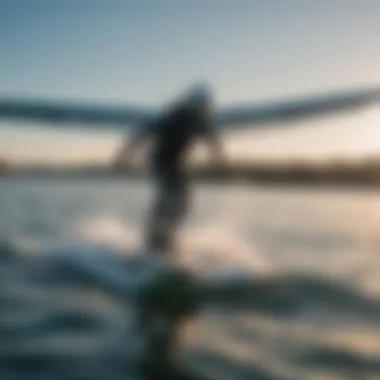

Selecting the right water conditions and location is paramount when it comes to wing foiling. Unlike some other water sports, wing foiling heavily relies on the interplay between wind and water. Not paying attention to these dynamics can lead not only to a frustrating session but also to safety risks. Superficial spots might seem attractive but can quickly turn into tricky situations if conditions are not favorable. Thus, it's crucial to be informed and to favor locations that foster a good learning environment.
Identifying Suitable Spots
When searching for suitable spots to practice wing foiling, certain characteristics should guide your decision. First off, it’s essential to find areas that are not overcrowded with other water users. Busy beaches can lead to collisions or unexpected waves that haphazardly alter your ride.
Next, look for flat-water areas with minimal obstructions. Lakes, bays, or estuaries often serve as excellent starting points. They offer calm conditions which allow beginners to focus on mastering balance and basic techniques without the distraction of sharp waves or currents. Local forums or social media groups like Facebook can be treasures of information for these kinds of spots. Ask locals for recommendations, as they can point you to hidden gems that cater specifically to wing foilers.
Understanding Wind Patterns
Just as a golfer studies the terrain and a sailor the tides, you must develop a keen sense of the wind. Understanding how wind patterns operate in your chosen location can make a world of difference when it comes to your experience on the water. Start by observing the local wind conditions at different times of the day. In most places, wind conditions tend to be more favorable mid-afternoon.
Look for consistent wind direction and speed—steady winds between 12 and 20 knots are typically ideal for beginners. Gusty or shifting winds can be tricky, requiring a level of skill not yet attained by novices. Utilize local weather apps or websites to monitor real-time conditions. Sites like Reddit often have sections where experienced riders share their findings, which can be of significant help.
Weather Conditions Impact
Weather can greatly affect your wing foiling experience; therefore, it should never be an afterthought. Apart from wind speed, you should also monitor temperature and precipitation. In cooler regions, ensure that you are equipped with appropriate gear, such as wetsuits or dry suits to fend off hypothermia. Rain can make things slippery and reduce visibility, which isn’t exactly a recipe for success.
Being attentive to changing weather can inform your decision-making while on the water. Check the forecast before heading out. Understanding whether a sudden storm is brewing can help you dodge potential hazards. It’s wise to have contingency plans—like nearby places for quick shelter—just in case you need to exit the water rapidly.
In summary, by putting effort into understanding water conditions, identifying suitable spots, recognizing wind patterns, and staying aware of weather impacts, you’re not just enhancing your skill but also ensuring a safer and more enjoyable wing foiling experience.
"A good sailor knows the sea; a wise one knows its winds."
Ultimately, once you've got a handle on these elements, you’ll find that wing foiling becomes more intuitive and pleasurable.
Safety Considerations
Safety should always be at the forefront when it comes to wing foiling. Unlike some other water sports, wing foiling involves both wind and water dynamics that can change rapidly. Therefore, understanding safety considerations ensures not only your protection but also the safety of others around you. This section breaks down essential safety practices to foster a responsible and enjoyable experience on the water.
Pre-Session Checks
Before embarking on your wing foiling adventure, it’s crucial to conduct thorough pre-session checks. These checks serve as your first line of defense against accidents or mishaps. Here are some key points to keep in mind:
- Inspect Your Gear: Look for any visible damage on the wing bladders and check the lines for frays or tears. Inflatable wings should be fully inflated and free from leaks.
- Know Your Conditions: Familiarize yourself with the wind and tide conditions on that day. If it’s gustier than you expected, you might want to reconsider your outing.
- Essential Safety Equipment: Always wear a suitable impact vest, a helmet, and a leash. The leash helps in attaching the wing to you, preventing loss in case of a fall.
Checking these aspects might seem tedious, but as the saying goes, "better safe than sorry." Taking a few moments can save you from potential injuries and a whole lot of hassle.
Emergency Procedures
Even with all precautions, emergencies can occur. It’s vital to have a plan in place to ensure a swift response if something goes awry. Here’s how to handle various emergency situations while wing foiling:
- Tether Scenarios: If you find your wing caught in the wind, stay calm. Let go of the wing but make sure you're still attached to your board via a leash. Swim to retrieve your wing.
- Cap-sized Boards: In case your board flips over, approach it from the back. Kick your legs to gain momentum and bring the board upright without losing your position. This tactic can make all the difference in getting back to the surface promptly.
- Rescue Signals: If you're in distress, use universal signals like waving your arms above your head or holding your life vest. It's also a good idea to familiarize yourself with rescue procedures from local water sports organizations.
"An ounce of prevention is worth a pound of cure."
These procedures may not be on your mind when the wind is at your back, but remembering them can gauge how effectively you manage unexpected situations.
Understanding Right of Way
Navigating water while wing foiling involves understanding the right of way, which is crucial for preventing collisions with other watercraft or fellow foilers. Here’s what you need to know:
- Rules of Navigation: As a general rule, the person on the starboard tack has the right of way over the person on the port tack. This means if you're coming up on someone and your right side (starboard) is facing them, you should maintain your course.
- Avoiding Conflicts: When approaching other water users—like kiteboarders or surfers— always give them space. Respect their maneuvers and stop if necessary to ensure safe passage.
- Adjust for Visibility: If visibility is poor or you feel unsure about your right of way, don’t hesitate to yield. It’s better to navigate slowly than risk a collision and injury.
By understanding these dynamics, you'll not only protect yourself but also contribute to a responsible wing foiling community.
Progressing in Wing Foiling
Progressing in wing foiling is not just about getting better at the sport; it’s a journey that intertwines skill, confidence, and a deeper understanding of the unique dynamics involved. As each session on the water unfolds, there is a world of possibilities to tap into. The more you practice, the more you realize that wing foiling is an intricate dance of balance, technique, and awareness of your environment. Evaluating your growth and fine-tuning your abilities are key elements that will ultimately enhance your experience on the water.
Skill Development Tips
Improving your skills in wing foiling requires a mix of patience, effort, and an openness to learn. Here are a few pointers to keep you moving forward:
- Practice Regularly: The adage "practice makes perfect" holds true here; the more time you spend on the water, the quicker you’ll pick up essential skills. Try to set aside specific days for practice.
- Observe Experienced Riders: Watching others can be quite enlightening. Pay attention to their posture, movements, and how they handle the wing in various wind conditions.
- Focus on Balance: This sport demands a solid sense of stability. Spend time in shallow water practicing balance on your board without the wing. Feeling comfortable on the board helps tremendously.
- Gradual Challenges: Once you’ve grasped the basics, don’t shy away from gradually increasing your challenges. Try tackling different conditions, maneuvering around obstacles, or even varying your speeds. You will learn much more than pushing yourself too fast.
- Record Your Progress: Consider keeping a journal or video logging your sessions. Reflecting on your growth, noting what works, and identifying what doesn’t can illuminate your path forward.
Common Mistakes to Avoid
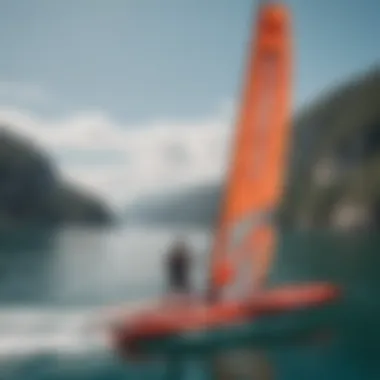

Even seasoned riders have their share of pitfalls, and as a beginner, you might find yourself in a few predictable traps. Here’s how to sidestep them:
- Skipping Fundamentals: Don’t rush the basics. Mastery of foundational skills, such as starting and stopping, is essential before venturing into advanced tricks.
- Neglecting Safety Gear: It can be tempting to hit the water without proper gear, but investing in a good helmet and impact vest makes a world of difference, especially as you experiment with new skills.
- Ignoring Local Conditions: Each body of water has its unique characteristics. Understand local currents, wave patterns, and wind conditions thoroughly before diving in. It's about reaping fun, not facing avoidable challenges.
- Overexerting: Trying to push through fatigue not only hampers your ability to learn but can also lead to accidents. Listen to your body and learn when to call it a day.
- Comparing Yourself to Others: Everyone progresses at their own pace. Instead of focusing on where others are, concentrate on your journey. Celebrate every small success.
Learning New Tricks
Once you've got the basics down and have honed your skills, the realm of tricks and advanced maneuvers opens up before you. Here are avenues to help you learn those dazzling tricks:
- Start Small: Begin with achievable tricks. Progress from simple turns to more dynamic moves like jumps or spins. Target achievable goals first.
- Break it Down: Deconstruct each trick into manageable components. Trying to master the full movement at once can overwhelm you. Focus on each part before putting it all together.
- Seek Instruction: If possible, consider taking lessons or working with a more experienced rider. Their guidance can shortcut your learning curve significantly.
- Be Open to Falling: Stumbles and falls are part of growth—don’t see them as failures. Each tumble can provide vital insights into what to adjust.
- Enjoy the Process: Remember to savor the learning journey. Each trick mastered adds excitement and keeps the love for the sport alive.
"The only thing preventing your progression in wing foiling is your willingness to learn and adapt."
In sum, progressing in wing foiling calls for consistent practice, awareness of your surroundings, and a willingness to embrace both the joys and frustrations that accompany the learning process. The ocean rewards those who learn from every ride.
Building a Community
Building a community around wing foiling is of utmost importance, especially for beginners. Not only does this create a support system, but it also enhances the learning experience. The camaraderie among fellow enthusiasts can foster growth through shared experiences, tips, and advice. Through community engagement, beginners can gather insights that can be pivotal in accelerating their journey in this thrilling sport.
Finding Local Groups
The first step in establishing a sense of belonging is to find local groups. Many regions have clubs or informal gatherings for wing foiling where newcomers can connect with experienced riders. Local Facebook groups or platform-specific forums like Reddit can serve as a treasure trove of information about where and when to meet.
- Social Media: Many local wing foiling communities actively share information on Facebook, Instagram, or local event boards. Try searching for terms like "wing foiling clubs [your area]" to find relevant groups.
- Meetup.com: This site often lists gatherings for various sports, including wing foiling. Participating in these can be a great way to meet new people and get on the water together.
- Local Shops: Surf shops or sporting goods stores typically have bulletin boards where events and meetups are posted. They may also host events themselves, providing another avenue to meet fellow enthusiasts.
Sharing Experiences
Sharing experiences not only enriches individual journeys but also weaves a stronger communal fabric. Many beginners feel overwhelmed, and hearing stories from seasoned wing foilers can provide them with both inspiration and practical knowledge. When you discuss your victories and defeats, you help others learn as well. This exchange of information can occur in numerous ways:
- Online Forums: Utilize platforms such as Reddit to discuss your experiences. You can ask questions or share what you learned during a recent session.
- Social Media: Posting pictures or videos from your sessions on Instagram or Facebook and tagging local groups can spark conversations with others who might have tips or similar stories.
- Workshops: Local clubs may offer workshops where participants can share knowledge and techniques. Being involved in these enhances learning and builds rapport with other riders.
Participating in Events
Participation in local events or competitions can significantly deepen your involvement in the wing foiling community. Engaging in these activities is not just about competition; it showcases your commitment and passion for the sport. Events can range from friendly meetups to more structured competitions. Here are some points to consider:
- Local Competitions: Even if you’re just starting out, local competitions often welcome all skill levels. It’s an opportunity to test your abilities and meet others at the same level.
- Group Rides: Many communities organize group rides. This is not just fun, but also a great way to learn from those more experienced. Techniques often get shared on the water, creating a dynamic learning environment.
- Festivals and Expos: These are excellent occasions to learn about new gear, watch demonstrations, and participate in workshops. Such events can expose you to professional riders, and even a bit of their expertise can go a long way.
Building a community not only enhances the joy of wing foiling but also creates opportunities for growth and improvement.
In summary, the journey in wing foiling doesn't merely lie in mastering the techniques but is equally about fostering connections with others. As you tap into local groups, share experiences, and engage in events, you will discover that this shared adventure can be as rewarding as the ride itself.
Engaging with a community creates a supportive environment, making your transition into wing foiling smoother and much more enjoyable.
Recommended Reading
One of the cornerstones of education is reading. There are many insightful books available for wing foiling enthusiasts. These often cover everything from the technical aspects of equipment to safety protocols. Books such as "The Complete Guide to Wing Foiling" and "Mastering the Wind" provide a solid theoretical foundation and practical insights.
- Focus Areas:
- Techniques and skills
- Safety best practices
- Environmental considerations
Engaging with these texts not only enhances your understanding but also allows for a deeper comprehension of the sport’s nuances. Consider hunting down titles through libraries or reputable online retailers to expand your collection.
Online Tutorials and Videos
With technology at our fingertips, online tutorials have revolutionized learning. Platforms like YouTube offer myriad video tutorials tailored specifically for beginners. These resources often feature experienced instructors demonstrating various maneuvers, from take-offs to advanced tricks. Watching these lessons can clarify techniques that are hard to grasp through text alone.
- Benefits of Online Resources:
- Visual learning helps with technique understanding
- Access to diverse instructors and styles
- Flexible pacing for personal learning journeys
Furthermore, consider following well-known kiteboarding channels. Many have dedicated videos on wing foiling that introduce and break down skills effectively.
Expert Consultation
While self-studying provides a solid base, consulting with experts can propel your abilities to new heights. Seek out local instructors or seasoned practitioners in your area. A tailored lesson can address your specific needs for improvement, offering personalized feedback that online resources simply can't provide.
- How to Find Experts:
- Attend local wing foiling events or meet-ups
- Utilize social media platforms like Facebook and Reddit to connect with local communities
- Join clubs or schools dedicated to water sports
It’s often said that learning is a journey, not a destination. Expert insights can illuminate your path and bridge gaps in knowledge that may not be evident through independent learning.
Accessing these additional resources is not just a formality; it’s an investment in your journey as a wing foiler. Equip yourself with the right materials and guidance, and watch your skills soar.










